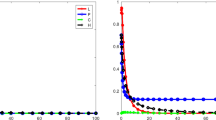Abstract
Maximizing the average rate of energy intake (profitability) may not always be the optimal foraging strategy for ectotherms with relatively low energy requirements. To test this hypothesis, we studied the feeding behaviour of captive insectivorous lizards Psammodromus algirus, and we obtained experimental estimates of prey mass, handling time, profitability, and attack distance for several types of prey. Handling time increased linearly with prey mass and differed significantly among prey types when prey size differences were controlled for, and mean profitabilities differed among prey taxa, but profitability was independent of prey size. The attack distance increased with prey length and with the mobility of prey, but it was unrelated to profitability. Thus, lizards did not seem to take account of the rate of energy intake per second as a proximate cue eliciting predatory behavior. This information was combined with pitfall-trap censuses of prey (in late April, mid-June and late July) that allowed us to compare the mass of the prey captured in the environment with that of the arthropods found in the stomachs of sacrificed free-living lizards. In April, when food abundance was low and lizards were reproducing, profitability had a pronounced effect on size selection and lizards selected prey larger than average from all taxa except the least profitable ones. As the active season progressed, and with a higher availability of food, the number of prey per stomach decreased and their mean ize increased. The effect of profitability on size selection decreased (June) and eventually vanished (July–August). This variation is probably related to seasonal changes in the ecology of lizards, e.g. time minimization in the breeding season as a means of saving time for nonforaging activities versus movement minimization by selecting fewer (but larger) prey in the postbreeding season. Thus, the hypothesis that maximizing profitability could be just an optional strategy for a terrestrial ectothermic vertebrate was supported by our data.
Similar content being viewed by others
References
Anderson RA, Karasov WH (1981) Contrasts in energy intake and expenditure in sit-and-wait and widely foraging lizards. Oecologia 49:67–72
Barnard CJ, Brown CAJ (1981) Prey size selection and competition in the common shrew. Behav Ecol Sociobiol 8:239–243
Bennett AF (1980) The thermal dependence of lizard behaviour. Anim Behav 28:752–762
Cummins KW, Wuycheck JC (1971) Caloric equivalents for investigations in ecological energetics. Mitt Int Verein Theor Angew Limnol 18:1–158
Dawson WR (1975) On the physiological significance of the preferred body temperatures of reptiles. In: Gates D (ed) Biophysical ecology. Springer, Berlin Heidelberg New York, 443–473
Diaz JA (1991) Historia Natural de Psammodromus algirus. Ecologia de un organismo modelo de ambientes mediterráneos. PhD. Dissertation, Universidad Complutense, Madrid, Spain
Diaz JA (1992) Choice of compass directions around shrub patches by the heliothermic lizard Psammodromus algirus. Herpetologica 48:293–300
Diaz JA, Carrascal LM (1990) Prey size and prey selection of Psammodromus algirus (Lacertidae) in central Spain. J Herpetol 24:342–347
Diaz JA, Carrascal LM (1991) Regional distribution of a Mediterranean lizard: influence of habitat cues and prey abundance. J Biogeogr 18:291–297
Diaz JA, Diaz M (1991) Estimas de tamaños y biomasas de artrópodos aplicables al estudio de la alimentación de vertebrados insectivoros. Doñana, Acta Vertebrata 17:67–74
Freed AN (1982) A treefrog's menu: selection for an evening's meal. Oecologia 53:20–26
Goss-Custard JD (1977) Predator responses and prey mortality in the redshank, Tringa totanus (L.), and a preferred prey, Corophium volutator (Pallus). J Anim Ecol 46:21–35
Greene HW (1988) Antipredator mechanisms in reptiles. In: Gans C, Huey RB (eds) Biology of the Reptilia, vol 16. Allen Press, New York, pp 1–152
Huey RB (1982) Temperature, physiology and the ecology of reptiles. In: Gans C, Pough FH (eds) Biology of the Reptilia, vol 12. Academic Press, London New York, pp 25–91
Huey RB, Pianka ER (1981) Ecological consequences of foraging mode. Ecology 62:991–999
Jaeger RG, Barnard DE (1981) Foraging tactics of a terrestrial salamander: choice of diet in structurally simple environments. Am Nat 177:639–664
Loop MS (1974) The effect of relative prey size on the ingestion behavior of the Bengal monitor, Varanus bengalensis (Sauria: Varanidae). Herpetologica 30:123–127
Montgomerie RD, Eadie JMcA, Harder LD (1984) What do foraging hummingbirds maximize? Oecologia 63:357–363
Nagy KA (1983) Ecological energetics. In: Huey RB, Pianka ER, Schoener TW (eds) Lizard ecology. Studies of a moder organism. Harvard University Press, Cambridge, pp 24–54
Paulissen MA (1987) Optimal foraging and intraspecific diet differences in the lizard Cnemidophorus sexlineatus. Oecologia 71:439–446
Peters RH (1986) The ecological implications of body size. Cambridge University Press, Cambridge
Pough FH (1980) The advantages of ectothermy for tetrapodes. Am Nat 115:92–112
Pough FH, Andrews RM (1985) Energy costs of subduing and swallowing prey for a lizard. Ecology 66:1525–1533
Rose B (1981) Factors affecting activity in Sceloporus virgatus. Ecology 62:706–716
Schoener TW (1979) Generality of the size-distance relation in models of optimal feeding. Am Nat 114:902–914
Sherry TW, McDade LA (1982) Prey selection and handling in two neotropical hove-gleaning birds. Ecology 63:1016–1028
Sih A (1980) Optimal behavior: can foragers balance two conflicting demands. Science 210:1041–1043
Skoczylas R (1978) Physiology of the digestive tract. In: Gans C, Gans KA (eds) Biology of the Reptilia, vol 8. Academic Press, London New York, pp 589–717
Stamps J, Tanaka S, Krishnan VV (1981) The relationship between selectivity and food abundance in a juvenile lizard. Ecology 62:1079–1092
Stephens D, Krebs JR (1986) Foraging theory. Princeton University Press, Princeton
Tinbergen J (1981) Foraging decisions in starlings (Sturnus vulgaris L.). Ardea 69:1–67
Werner EE, Gilliam JF, Hall DJ, Mittelbach GG (1983) An experimental test of the effects of predation risk on habitat use in fish. Ecology 64:1540–1548
Zach R, Falls JB (1978) Prey selection by captive ovenbirds (Aves: Parulidae). J Anim Ecol 47:929–943
Author information
Authors and Affiliations
Rights and permissions
About this article
Cite this article
Díaz, J.A., Carrascal, L.M. Variation in the effect of profitability on prey size selection by the lacertid lizard Psammodromus algirus . Oecologia 94, 23–29 (1993). https://doi.org/10.1007/BF00317296
Received:
Accepted:
Issue Date:
DOI: https://doi.org/10.1007/BF00317296




